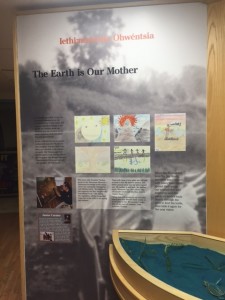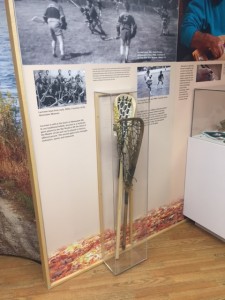Upon meeting some of the members of the Akwesasne Mohawk Tribe, our Capstone group was welcomed very warmly. Our class, a small group of predominantly European heritage, has little knowledge on the history and culture that these Haudenosaunee natives hold close. This trip to the Akwesasne Mohawk Tribe was an introduction, for us, to their stories and their connection to nature, which we will be studying throughout this semester.
A historian working at the library of the Cultural Center Museum told us about a common creation story representative of the Haudenosaunee culture. We also examined many different art pieces and learned historical facts of the Akwesasne culture. Much of the artwork related to their connection to nature; most baskets and headpieces were made from ash trees and animal remains.
Lacrosse, a sport that originated in native communities, is still a large part of the Akwesasne culture. The museum featured many types of wooden sticks. Lacrosse sticks, before industrialization on the reservation, were made solely of wood and natural materials. Historically, a lacrosse player was able to venture into the woods, with the stick maker, and choose the tree that his stick would be made from. This provided the athlete with a deep connection between his sport and the environment.
Many members of the tribe are currently artists. The museum features many paintings and baskets produced by current residents, and antiques donated by tribe members and others. The museum also touched on the iron work that those in the tribe have contributed to over the past decades, and how that is changing now. Though ironworking was once a career for some ancestors, the trade has seemed to fade out.
Our visit to the tribe was refreshing. It gave us a more in-depth look at the culture, and the relationship between nature and the Akwesasne tribe. We were able to meet with the Akwesasne Environmental Division and share our current project proposals and seek individual help with members of the division.
We also learned a great deal about the Akwesasne Cultural Restoration program. The program is funded by a settlement from the environmental injustice the tribe once faced at the hands of the General Motors Corporation, which is adjacent to the reservation. The program runs for four years and aspires to teach the tribe members an understanding of the nature around them, skills such as fishing and hunting, horticultural practices and medicinal properties of plants, as well as the Akwesasne language. Although students in the program face challenges in absorbing all of this information, each student learns a new skill and is able to share their experience throughout the community.
It was evident to our class, just from our one-day visit, that the Akwesasne culture is making great strides in sustainability, in environmental education, and in keeping culture alive and vibrant within the tribe. We were honored to be in their presence and learning their way of life. We are ecstatic about the connections we have made and the progress we will make in our focus in understanding the environmental impact on the Akwesasne Mohawk Reservation.


